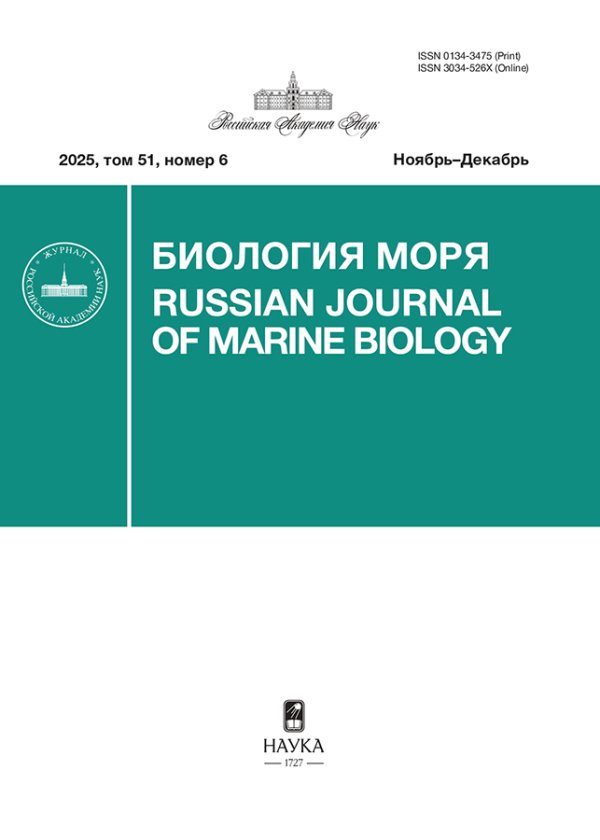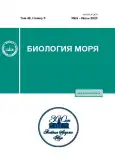Vol 49, No 3 (2023)
- Year: 2023
- Published: 01.05.2023
- Articles: 7
- URL: https://journals.rcsi.science/0134-3475/issue/view/7693
Full Issue
ОБЗОР
Muscle Complexes in the Jaw Apparatus of Teleost Fishes: Structure and Function
Abstract
Striated muscles of the teleost fishes sometimes combine into complicated “supramuscular” complexes. In these complexes, individual muscles are connected into parallel combinations and/or in sequential series. A group of parallel muscles combines their forces to carry out a single powerful functional act. Consistently connected muscles obtain thereby an increased amplitude and speed of movements. For the described “supramuscular” complexes, the term “supermuscle” has been proposed. The paper provides an overview of the features of the structure and the function of the supermuscles of the teleost fishes heads with parallel and sequential structures. A variety of causes for the formation of muscle complexes is discussed for different taxa of Teleostei.
 149-165
149-165


ОРИГИНАЛЬНЫЕ СТАТЬИ
Biochemical and Ultrastructural Changes in the Microalgae Tisochrysis lutea (Bendif et Probert) (Haptophyta) at different stages of growth in enhancement culture
Abstract
In our study we investigated the growth, biochemical composition, and ultrastructure of Tisochrysis lutea microalgae in enrichment culture during 30 days experiment. The number of T. lutea cells increased throughout the experiment. We noted an increase in the size and number of lipid droplets containing fatty acids and carotenoids, including fucoxanthin, in the exponential and stationary phases of their growth. It has been established that the total content of carotenoids reaches a maximum in the stationary phase and decreases in the dying phase. During the stationary phase, exocytosis is observed in cells with the release of lipid droplets. This study demonstrates the potential of the T. lutea clone MBRU_Tiso-08 from the Marine Biobank Bioresource Collection of the NSCMB FEB RAS as a raw material for domestic biotechnology aimed at the combined extraction of carotenoids (including fucoxanthin) and lipids (including docosahexaenoic and eicosapentaenoic fatty acids).
 166-174
166-174


The Structure of the Zooplankton Community in Spitsbergen Waters during the Winter Period
Abstract
The plankton community was collected during the winter season from the Isfjord aquatic area, on the western coast of Spitsbergen Island, during the interval November 30 to December 6, 2015. Sampling was carried out with a plankton net and bathometric catches on board of the research vessel Dalnie Zelentsy. The assemblages of micro- and mesoplankton from several aquatic areas of the central part of Isfjord have been studied qua-litatively and quantitatively. These areas contain waters with different hydrological structures. We noted that the number of nauplii of small copepods in samples varied significantly depending on sampling method. The main emphasis of this research is placed on the methodology of plankton study in the Arctic waters during winter seasons.
 175-185
175-185


Content of Trace Elements in Tissues of Gastropod Mollusks of the Family Buccinidae (Gastropoda) off the Coasts of South-Eastern Sakhalin (the Sea of Okhotsk)
Abstract
The content of Pb, Cd, Cu, Cr, Mn, Ni, Fe, and As in the muscle, mantle, and digestive glands of the gastropod mollusks Neptunea excelsior, N. behringiana, N. multistriata, and N. varicifera, as well as Buccinum verkruezeni, living near the coasts of the South-Eastern Sakhalin has been estimated. Representatives of the ge-nera Neptunea and Buccinum showed some differences in the ranges of variation and series of value sequences of trace element concentrations in the muscle. Exceeding the hygienic standard for the content of As in the hepatopancreas was found in all the studied mollusks, and in the muscle – in all, except for N. behringiana. The maximum permissible level of Cd concentration was exceeded in the hepatopancreas of N. multistriata.
 186-194
186-194


Dimensional and Physiological-Biochemical Parameters of Erythrocytes and Gill and Heart Indices in Some Benthic Fish of the Black Sea Coast of the Southeastern Crimea
Abstract
The dimensional and physiological-biochemical parameters of erythrocytes, as well as the gill and heart indices were studied in five species of marine benthic fish. The black scorpionfish Scorpaena porcus Linnaeus, 1758 and the shore rockling Gaidropsarus mediterraneus Linnaeus, 1758 differed from the other species in a larger mass of the heart and gill apparatus, which indicates more efficient transport capabilities of the circulatory system of these fish. The linear size characteristics of erythrocytes of a cartilaginous fish, the thornback ray Raja clavata Linnaeus, 1758, were 1.5–2 times higher than those of erythrocytes of S. porcus, which were the largest among the studied teleosts. The sizes of erythrocytes of three other teleost species differed insignificantly. The amount of hemoglobin per unit surface area of erythrocyte, which reflects the efficiency of hemoglobin saturation with oxygen, insignificantly varied (0.05 to 0.071 pg/mm2) among the bony fish stu-died. In contrast, in the thornback ray this parameter was 2.7–3.8 times lower. The intracellular glycogen concentration, which characterizes the degree to which the erythrocyte is independent of glycemic fluctuations, was highest in cells of S. porcus (305.2 ± 35.1 mg %), while it was lowest in erythrocytes of the thornback ray R. clavata (142.8 ± 15.1 mg %). The ecto-ATPase activity was higher in large erythrocytes of S. porcus, R. clavata, and Uranoscopus scaber (4.8, 3.1, and 1.6 µmol Pin/min/mL of erythrocytes, respectively) than in smaller erythrocytes of Crenilabrus tinca and Gaidropsarus mediterraneus (0.5 and 0.4, µmol Pin/min/mL of erythrocytes, respectively). This confirms the assumption that erythrocytes use the thermal energy from hydrolysis of extracellular ATP to “warm up” their own membrane, which leads to the change in the rheological characteristics of blood in the capillary blood flow.
 195-204
195-204


Morphological Analysis of the Hemolymph Cell Composition in the Bivalve Mollusk Anadara broughtonii Schrenck, 1867 (Sea of Japan)
Abstract
The hemolymph cells of the ark clam Anadara broughtonii were examined using light microscopy, flow cytometry and gradient centrifugation. All three methods of analysis made it possible to identify two main types of cells in the hemolymph of the ark clam Anadara broughtonii – large granular erythrocytes and small agra-nular amebocytes. Erythrocytes accounted for 95.6 ± 0.9% of the total number of hemolymph cells. Erythrocytes were hemoglobin-containing cells with a great number of granules in the cytoplasm, a low nuclear-cytoplasmic ratio (NCR) and a lower intensity of cellular respiration compared to amebocytes. Amebocytes are cells of predominantly irregular shape with a high number of cells that do not contain or contain no more than 10 granular inclusions in the cytoplasm. All types of hemocytes found in the ark clam hemolymph demonstrated the same ability to spontaneously produce reactive oxygen species. For the first time, it has been shown that red blood cells of the ark clam Anadara broughtonii are capable of phagocytosis. At the same time, amebocytes absorbed on the average two times more zymosan particles (10.3 ± 0.7 pcs.), compared to erythrocytes (5.3 ± 0.1 pcs.).
 205-214
205-214


КРАТКИЕ СООБЩЕНИЯ
Alopiidae – A New Record of the Thresher Shark Family for the Fauna of Russia
Abstract
The capture of a thresher shark Alopias vulpinus (TL 136.5 cm) in Peter the Great Bay (Sea of Japan) on September 5, 2022 is reported. A description of the specimen, including surface morphometric parameters, vertebraе counts, the number of tooth rows, and the number of intestinal valve turns, is presented.
 215-216
215-216












